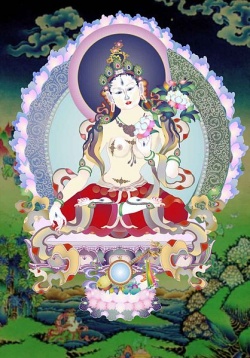White in Buddhist Color Symbolism
White is not really a color. It occurs when the whole spectrum of light is seen together or when red, yellow and blue colors are mixed. Everything is present in white; nothing is hidden, secret or undifferentiated.
Thus Saraswati, the goddess of learning and knowledge, is shown white in color. Indeed knowledge and learning should not be hidden, but be open and available to all.
White color is thought to have a very cold quality, as in snow, or an extremely hot quality, such as a burning metal. Either one can be life threatening and reminds us of death and the end of things. Fittingly, therefore, the goddess Tara in her form which grants longevity to worshippers is depicted as white hued (White Tara). She also denotes purity, holiness and cleanliness and is 'the one who leads out beyond the darkness of bondage'.
White is a color that both incorporates, and set things apart from the rainbow spectrum of everyday life.
The color white appears in numerous Buddhist episodes, one of the most well known being the birth of Buddha. Legend states that Queen Maya, mother of Buddha dreamt of a white elephant that flew through the air and touched her right side with its trunk. Now elephants are well known for their strength and intelligence, and are also associated with gray rain clouds and fertility. Indeed rainwater means that the seeds will be able to germinate and vegetative life will be able to spring forth.
The white color of the majestic animal adds to this narrative an element of purity and immaculacy. In his former lives the Buddha had been an elephant several times, as mentioned in the Jatakas, or tales of his previous births. The white elephant is believed to have been the future Buddha himself who descended from heaven so that he could be born. It thus also represents for queen Maya a chaste birth, or the element of the triumph of spirit over the flesh.
